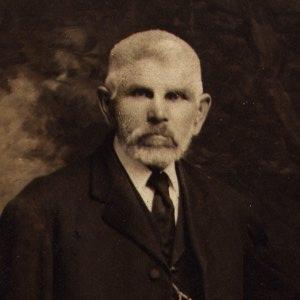

Our family can trace its American roots to Anton Spath's arrival in the middle 1800's. My great grandfather (Edward M. Spath I) was Anton's youngest son. I have spent a considerable amount of time searching libraries, court houses, cemeteries, and other places looking for bits and pieces of the past. Many relatives and friends have expressed an interest in genealogy. Because of this interest, I have taken the effort to collect some of the stories of Anton Spath, his family, and their Cross Keys' community, so that it can be shared with others. This task is not complete. Portions of the family tree need to be expanded or corrected, questions need to be answered, and much more work is necessary. In addition to more factual data, pictures of the family and the Cross Keys' area during the 1800's or early 1900's would enhance the story that is contained in these pages. Everyone is encouraged to help. Information, pictures, and maps of Baltimore City and County have been included to aid the research effort and to give a better understanding of the area during Anton Spath's life.
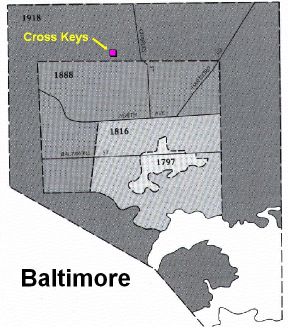
Anton was born on March 3, 1835 in Germany.(1) Resource material suggests several locations for the place of his birth. Based on all of the information that I have reviewed, it is most likely that Anton was born in Dietzenbach, Germany. According to Passenger Ship Records, family members that visited Uncle Anton in 1910 were born and raised in Offenbach, Germany, not too far from Frankfurt. Offenbach has a population of 116,000 in the city. Herbert W. Spath Sr. said that Anton came from Düsseldorf, about 20 miles southwest of Essen.(2)
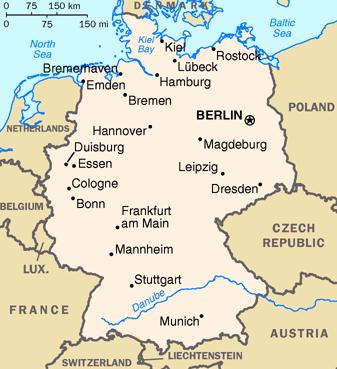
Records at the Family History Library operated by the Church of Jesus Christ of the Latter Day Saints (LDS) show that Anton was born in Dietzenbach, Germany. Information from Christoph Spath also says that Anton was born in Dietzenbach. The city of Dietzenbach is about 10 miles southeast of Frankfurt and has a population of approximately 35,400.
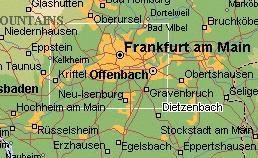
The name Spath comes from the German word spät, meaning late and was pronounced shpat. Over time it was changed to Spath or Spaeth. Different spellings of the name such as Spath, Spathe and Spaeth come from the same German surname. Variations of the spelling in resource material should be carefully evaluated. A different spelling may be a legitimate variation, but may simply be a misspelling. For example, the Woods Baltimore City Directory spells the name as Antony Spates in 1898 and Anthon Spath in 1899. Both are incorrect.
Anton grew up when Germany was a federation of sovereign states. The German Federation survived until 1866. (3) Not much information is available about Anton's childhood. He was 22 when he traveled to America. The 1900 U.S. census says that Anton's year of immigration was 1856, while the 1910 census says that it was 1855. Based on research submitted to the Family History Library in Salt Lake City, Anton's parents were Heinrich Spath and Anna Maria Juenger Spath (married on October 3, 1820). Anton was the sixth of their seven children.
Information listed in the 1900 census says that Anton
came to the United States in 1856.
Baltimore was a popular port of entry for immigrants in the
nineteenth century. In the late 1850's, Baltimore was the
third largest city in the United States with a population of
212,418.(3a) Between 1833 and 1876, it is reported that
272,218 German immigrants arrived in Maryland. The largest wave
of German settlers arrived during the decade of 1850 to 1860. (4)
Ellis Island in New York was the most popular port of entry for
Germans from 1850 to 1855 with 552,117 German arrivals as compared
to 46,437 German arrivals in the Baltimore port for the same time.
(*web*) Some Spaths might have arrived in New York and traveled
to Baltimore via ground transportation. Roughly 600,000 people
arrived at the Baltimore port between 1868 and 1900. Many who arrived
were Germans because the steamships that carried them sailed from
Bremen, Germany. Bremen is a city
near the mouth of the Weser in the North German Plain. Ships
belonging to the North German Lloyd Lines were named:
Braunschweig, Léipzig, Berlin, Baltimore, Bremen,
Nürnberg, and Ohio. The initial voyage of this line occurred
in March 1868. (5) (6) Many Germans who came to America after
1830 left their homeland for economic reasons. Germany
experienced an abortive revolution in 1848. (7) The liberal
refugees of the abortive revolution were called '48ers and
settled mostly north of the Mason Dixon Line.(8) Approximately
496 Spaths are listed in the 1880 federal census. Northern and
mid-western states accounted for the majority of Spaths.(8a) For
example New York had 80, Pennsylvania 78, Indiana 71, Ilinois 49,
Minnesota 44, Missouri 42, Wisconsin 30, Michigan 28, while New
Jersey had 9, Texas 2, Maryland 0, Virginia 0 and West Virginia 0.
These are not precise numbers. Some people (such as Anton) were
missed by the census takers, but they give a good estimate of the
approximate scatter of Spaths about the country.
| DATE | VESSEL | PASSENGERS | DESTINATION |
|---|---|---|---|
| Aug 29, 1846 | Albert | Cath.,Magd. | --- |
| Oct 19, 1846 | Johannes | A.M.,Marg.Elsie | Balt. MD |
| May 11, 1860 | Ferdinand | Anna | Cinn. OH |
| Jun 11, 1861 | Albert | Fried,Caroline,Catharine,Christine,Fried Jr. | IL |
| Dec 17, 1867 | Clara | Christoph | --- |
| Sep 16, 1871 | Leipzig | Adolph,Marie,John,Heinhrich | USA |
| Apr 9, 1875 | Braunschweig | Gustav,Henriette,Carl,Julius | USA |
| Apr 9, 1975 | Braunschweig | Ferdinand,Friedrich | USA |
| Sep 21, 1881 | Herman | Josef | USA |
| Apr 30, 1882 | Nurnberg | Carl | St.Louis |
| Mar 12, 1884 | Weser | Rosalie,Albert,Gorg,Wendelin,Crescenz,Josef,Roebus | TX |
| Jun 12, 1884 | Habsburg | Minna | Wisc. |
| May 1, 1889 | America | Lisette | Neb |
| May 9, 1890 | Rhein | Barbara,Josef | Balt. |
| Jun 9, 1890 | Rhein | Bertha | MO |
| Mar 25, 1884 | Stuttgart | Christine | Clev. |
| May 12, 1895 | Wittekind | Wally | St.Paul |
During the period from 1820 to 1897, at least 38 Spaths arrived at the port of Baltimore (See Table 1). I collected the list by going through the soundex of passenger ship records at the National Archives. Names were grouped by their travel companions. Soundex listings assign a 4-digit code to each person's last name. The first letter is taken and the remaining letters are coded with numbers. Similar sounding surnames usually receive the same soundex number. The soundex for Spath is S130. This is also the first four digits of a Spath's Maryland driver's license. Anton's name was not listed any time during the period from 1820 to 1897. Only two groups of Spaths are listed as arriving between 1820 and 1860. One group of three people arrived in 1846 on the vessel Johannes. Portions of the description fit Anton, such as a weaver and destined for Baltimore. Other data such as ages are inconsistent and lead to the conclusion that Anton was not part of that group.
| 1. | b, p, f, v |
|---|---|
| 2. | c, s, k, g, j, q, x, z |
| 3. | d, t |
| 4. | l |
| 5. | m, n |
| 6. | r |
Herbert Spath Sr. said that Anton came to America alone to avoid German military service. It is possible that he traveled under an assumed name, that the name listed on the ship's record was misread when it was indexed, that the name was not legible at all, or that the ship records have been destroyed. The 1900 census records say that Anton's "year of immigration" was 1856 and that he had been in the USA for 43 years.
It has been told that Anton came to America with his cousin. The cousin was supposed to be the head of the Frank Spath family. Daniel was Anton's nephew and was born in 1863, many years after Anton's arrival in America. It is possible that Daniel might have referred to as "the cousin." He had a son named Frank, a grandson Frank and also a great-grandson Frank. All the Spaths in the Baltimore area were said to be descendants of one of the two cousins. With the large number of Spaths entering the port of Baltimore, it is quite likely that other Spaths, not related to Anton or his cousin, decided to stay in the city even though other destinations may have been originally noted on the ship records.
Esther Spath Robbins met Frank Spath in December 1945 when she was a seasonal employee at the main Post Office in Baltimore. Frank also worked at the Post Office. As Esther stood in a Post Office line, Frank saw her Spath name tag. They found out that they were distant cousins, although they were not clear of the exact relationship. (9)
A ship named Minerva sailed from Bremen to Baltimore in September 1855 and included Maria Strohicker (age 18) as one of its passengers. It is possible that this passenger could have been the woman that Anton Spath married. Michael Strohicker (age 17) was also a passenger on the Minerva.(9a)
Baltimore Passenger and Immigration Lists for 1820-1872 include "Anton Spat" on the sailing vessel named Bark Stella that arrived in Baltimore on November 3, 1857 with 337 passengers. It says that Anton was 22 years old and had sailed from Bremen. He was a weaver. The record also says that his sisters, Margarethe Spat, age 25, and Maria, age 28 were on the same ship. (9b)



A hint of the occupation of people from the past can be obtained from many sources such as census records, city directories, newspaper articles, word of mouth, etc. Census records are collected every 10 years and in the 1970's could be found at the National Archives in Washington D.C., among other places. Many local libraries have microfilm copies of census records and access to on-line databases. Most of the data from the 1890 census are not available because it was destroyed in a fire. Records for 1880 and 1900 are accompanied by a soundex. I searched for Anton's name but did not find it listed in either the 1880 or the 1900 soundex.
The next step was to search the actual census records by looking in the proper census enumeration district for streets of Cross Keys. Each census record is broken down by supervisor's district and enumeration district. The enumeration districts are usually described in a reference book or on microfilm by ward and precinct or by street boundaries. In the 1880 Census, pages 2024 of enumeration district 242 (roll 496) listed dwellings in Cross Keys, but no Spaths were included. Streets and house numbers were not included for any of the Cross Keys residents. I also searched other areas of election district No. 9 such as Hampden, Davidville, Mt. Washington, Sweetair, and Clippier, and portions of Election District No. 3 for Melvale, but I found nothing useful.
My search of the 1900 Census was much more successful. Election District No. 9 was broken down into four precincts. Precinct 2 contained the Cross Keys portion of Falls Road. Street names are listed on the census sheet, there are no house numbers. Records for this area would be found in Enumeration District 41. As I was perusing sheet 33 of E.D. 41 (roll 607), the name Anton Path jumped out at me. That was very close to the correct spelling. It was missing only the letter "S". The house was located on Falls Road. I looked across the census page and found his occupation listed as landlord, years of marriage as 41, birth place as Germany and birth date as March 1835. They were all the same! It must be Anton Spath. The record said that his parents were born in Germany and listed Anton's year of immigration as 1856. It also listed his sister Annie M. at the same address and said that she was born in October 1827. LDS records suggest that Maria was born in October 1828.
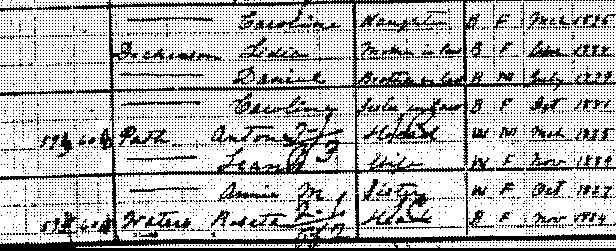

| DATE | NAME | OCCUPATION | RESIDENCE | |
|---|---|---|---|---|
| - | - | no Anton listings from 1873 to 1889 | ||
| 1890 | - | - | - | |
| 1891 | - | - | - | |
| 1892 | - | - | - | |
| 1893 | - | - | - | |
| 1894 | - | - | - | |
| 1895 | Spath, Anton | gardener | Falls Road near tollgate | |
| 1896 | Spath, Anton | farmer | Falls Road near tollgate | |
| 1897 | - | - | - | |
| 1898 | Spates, Antony | farmer | Melvale | |
| 1899 | Spath, Anthon | farmer | Cross Keys | |
| 1900 | - | - | - | |
| 1901 | - | - | - | |
| 1902 | Spath, Anton | lab | Cross Keys | |
| 1903 | Spath, Anton | lab | Cross Keys | |
| 1904 | Spath, Anton | - | Cross Keys | |
| 1905 | - | - | - | |
| 1906 | Spath, Anton | - | Falls Road near Cold Spring Lane | |
| 1907 | Spath, Anton | - | Falls Road near Cold Spring Lane | |
| 1908 | Spath, Anton | - | Falls Road near Cold Spring Lane | |
| 1909 | Spath, Anton | - | 223 Falls Road | |
| 1910 | Spath, Anton | - | 223 Falls Road | |
| 1911 | Spath, Anton | - | 223 Falls Road | |
| 1912 | Spath, Anton | - | 223 Falls Road | |
| 1913 | - | - | - | |
| 1914 | - | - | - |
On May 25, 1860 Anton Spath married Anna Maria Strohicker. He was 25 and had been in the USA for about two and a half years. She was 22 years old. According to information kept by the Maryland Hall of Records Commission, the ceremony was conducted by a person named Bush and took place in Baltimore. The record shows the spelling of the names of the bride and groom as Anton Spathe and Mary Strohicker. (10) Viola Johnson Gray told me that the name was spelled Strohecker. Anna Maria was born on March 29, 1838 in Germany. (11)
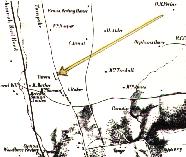
By 1865 the U.S. Civil War was coming to a close. Robert E. Lee surrendered to Ulysses S. Grant at the Appomattox courthouse on April 9, 1865. Six days later, Lincoln was shot at Ford's theater in Washington DC.(17b) Lincoln's funeral train departed Baltimore's Calvert Street Station and traveled along the Northern Central railroad tracks. At the end of 1865, Anton signed a lease for property along the same Northern Central railroad tracks that carried Lincoln's funeral train. The lease, dated December 29, 1865, was between Anton Spath and Charlotte E. Harper, William Pennington and Shirley Pennington for eleven acres of a tract of land described as Oakland Resurveyed. Under the agreement, Anton paid $100 annual rent.(12) The eleven acres were located between Jones Falls and the Northern Central railway tracks. (13)
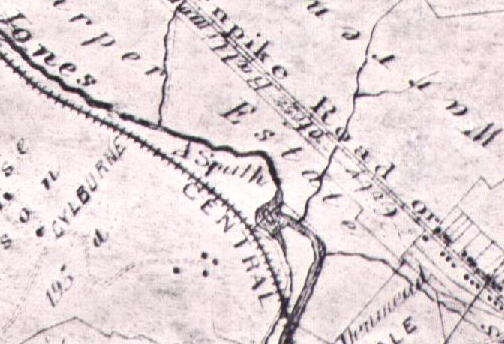
The Northern Central Railroad (NCRR) that ran adjacent to Anton's 11 acres was founded in 1854 by consolidation of the Baltimore and Susquehanna Railroad and lines from Harrisburg, Pennsylvania. (18) It served Baltimore City and the towns of central Maryland and Pennsylvania. A 60 mile ride from Baltimore to York, Pennsylvania took 4 hours and cost $1.75. Much of the white marble used for front steps was hauled down to Baltimore on the Northern Central tracks.(19)
Confederate troops opened fire on Fort Sumter on April 12, 1861. Newly elected President Lincoln called for 75,000 volunteers to put down the rebellion. In response, troops from Massachusetts and Pennsylvania traveled through Philadelphia to Baltimore's President Street Station on their way to the Nation's Capital. As the 35 train cars full of troops were individually pulled by horse from the President Street Station to the B&O train tracks at Camden Station, Baltimore citizens harassed the troops and barraged the cars with stones that shattered railroad car windows. The eighth car in the procession was stopped when sand, a ship anchor and cobblestones were dumped to block the tracks. The troops tried to return to President Street Station, but there was violence. Four soldiers were killed and three dozen were injured. Northern newspapers were enraged and wanted to "organize, arm, and push on to Baltimore to lay it to ashes". City politicians were concerned that another incident would cause much greater violence and wanted to eliminate the clash before it occurred. To prevent northern troops from reaching the city, Mayor Brown ordered a squad of Baltimore police to destroy the Northern Central Railroad bridges at Melvale, Relay House, and Cockysville on April 20, 1861. John Merryman was arrested on May 25, 1861 and held at Fort McHenry for burning the Northern Central Railroad bridges. The railroad bridge at Melvale was just south of the property that Anton would lease in 1865. (20)(20c)
Army encampments appeared during the Civil War in Druid Hill Park and other parts of the city. The army took prisoners from Gettysburg and Antietam to Baltimore.(20b) Baltimore had 44 forts, batteries, redoubts and armed camps during the Civil War. There were also unarmed camps (hospitals, POW's, etc.). Camp Melvale existed from 1861 to 1862 at Cold Spring Lane and Jones Falls in the Cross Keys area. Camp Melvale was also called Camp Small because the property had previously been owned by George W. Small. Jim, an office worker at Fleischmann's, said that the area west of the Fleischmann building is used as a debris dump for Baltimore Gas & Electric and was the site of Camp Small during the Civil War. It was used as a holding area for prisoners.
During the Civil War, the Northern Central line carried a greatly increased traffic load, generated much additional revenue, and was double tracked from Baltimore to York. In the figure below, the railroad tracks can be seen as they pass over the Jones Falls, near Melvale Station. The figure of the Melvale Distilling building from the 1800's was often used in advertisements for pure rye whiskey. Their main office was located at 45 S. Gay Street in Baltimore. A train can be seen approaching Melvale Station on the far left side of the figure.
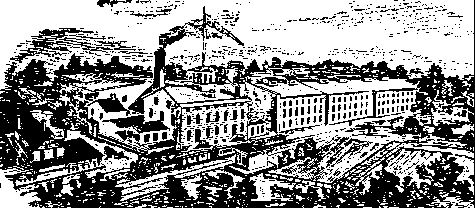
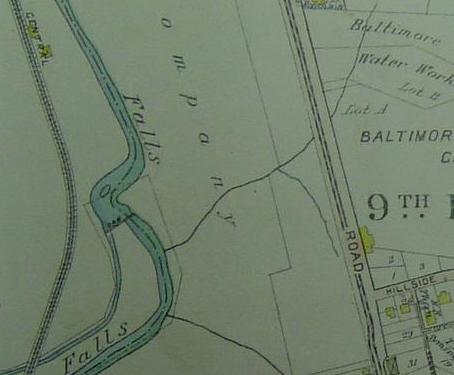
The Baltimore Country Club was organized in 1898 and a club house was built a year later. After the unique looking Roland Park water tower was constructed, water was delivered to every house in Roland Park. It did not, however, include any supply for the Cross Keys residents. (20d)
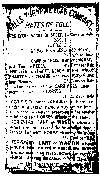
A toll sign from Falls Turnpike in 1890's
Source: Maryland Geological Survey Commission
The 1895 and 1896 Woods Baltimore City Directories list Anton's residence as Falls Road near tollgate. Anton's houses were built close to the Falls Turnpike Road. The legislature incorporated the Falls Road Turnpike Company in 1804 to construct a road from Baltimore to Richard Caton's lime kilns at Brooklandville. The cost of the road was $7500 per mile. Tollgates were placed at locations along the road where toll collections could be maximized. Most of the Baltimore turnpikes were out of operation by about 1910. (21) The location of the Baltimore turnpikes and railroads are shown on the figure below. (22)
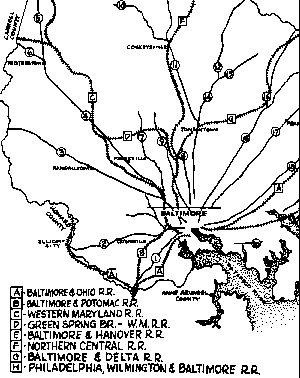
Source: A History of Baltimore County by Brooks and Rockel
A fee was charged according to the load that travelers carried on the Falls Turnpike. Wagons with narrow wheels were charged a higher fee because it was believed that they caused more road damage than wider wheels. (23) T.C. Robbins introduced the electric motor to street car service in 1885 on the Baltimore & Hampden Railway. It was reportedly the first electric railway operation in America. The electric equipment wore out by 1889 and the company went back to mule service. The Pikesville Reisterstown Emory Grove Railroad ran from Mt. Washington, along the Falls Turnpike Road, down Charles and Calvert to Baltimore Street. The name was later changed to the Baltimore and Northern. Operation started in 1897. (24) One of trolleys along Falls Road can be seen in the 1906 figure from the book Baltimore - A Picture History. Records at the Baltimore County court house in Towson show that Anton and his wife purchased the 11-acre tract of land in September, 1887, for $2,200. The deed, recorded in book number 134 J.W.S., listed the purchasers as Anton Späth and his wife Mary Späth. Initially, Anton owned property west of Falls Road, but later moved across the street to a duplex at 223 Falls Road. The exact date is not known. The other half of the duplex was smaller and was occupied by Stephen Penske, Stephen's wife Frances, and Frances' mother Augusta Philips. Baltimore City Directories might tell when the Philips moved into the Falls Road house.
After many years of inactivity, the Northern Central Railroad right-of-way was viewed as a potential home for part of a proposed north-south mass transportation system for the city. Planning was started about 1980 and the first 22.5 miles of track were opened for ridership in April 1992. Baltimore's Light Rail runs from its southern point in Glen Burnie to Baltimore's downtown area, along the Jones Falls, right past Melvale Station, across Lake Roland, and finally all the way to Hunt Valley.
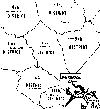
Naturalization records at the Hall of Records in Annapolis were searched for Anton's name, but it was not found. The 1900 Census lists the citizenship of the persons surveyed. It shows that Anton Spath was naturalized by its "na" designation in column 18. Many years later, a second search of records in Annapolis found three Spaths in the Naturalization index. They were Anton, Daniel and Ferdinand. The Naturalization record says that, in 1883, Anton appeared before the court and preyed to become a citizen of the United States. The Certificate of Naturalization was signed by the Clerk of the Circuit Court of Baltimore County on November 26, 1883. (26b)
Anton and his wife Anna Maria had four children that made it to adulthood. At least one additional child (Matilda) died shortly after birth.(27) She was Christina's twin sister. All of the children were born and raised in Baltimore. The children's names birth dates are listed below:
Anton Spath Jr. (age 22) married Mary Ziehl (age 24) on February 15, 1887 according to the records at the Baltimore City court house. Their oldest child, Herbert W. Spath, was born on June 13, 1890. Listings in the Baltimore City Directories show that Anton Spath Jr. was an insurance agent in Baltimore City from about 1888 to 1896 and a grocer from 1905 to 1910 (190 Falls Road). His father's house was on the east side of Falls Road and the grocery store was on the west side of the Road. He was listed in the directory as a florist from 1911 to 1918. Anton Jr. and his son Herbert Spath Sr. owned a florist shop on Wyndhurst and Lawrence Avenues in Roland Park until the Great War put them out of business. The florist shop was located near Wyndhurst Station, one of the stops on the Maryland and Pennsylvania Railroad. This narrow gauge railroad was called the Ma and Pa Railroad. In the Roland Park area, the tracks ran adjacent to Stoney Run and crossed Wyndhurst Avenue near the florist shop. Herbert Spath Jr. was given the sign that hung over the door of the florist shop. Jim Glover's cousin, Gary, found a copy of the Roland Park Walking Tour book that included the following item as stop 10 on tour number one.(27a)

The Roland Park Florist is the fourth florist to locate here, just outside the boundaries of the Park. It follows a tradition that began in 1894 when A. Spath & Son opened a florist at the same spot. The Covens family, owners of the present Roland Park Florist, have been in business since 1938.
Anton Jr. died on December 29, 1919 and is buried in Baltimore Cemetery. His wife Mary died earlier in 1919 on January 11th.
Several bodies are buried in the Baltimore Cemetery lot that was owned by Anton Spath Jr. The east (E) and west (W) designations usually indicated that infants or small children are buried in the grave. It is not clear if all of those buried were relatives. (36) Cemetery records indicated that the following were buried in Anton Jr.'s lot, J443:
An idea of when the two sons, Anton Jr. and Edward, went out on their own can be put together by looking at the yearly listings in the Baltimore City Directories. Anton Jr.'s name first appeared in 1888 when he was 22 years old and Edward's name appeared in 1891 when he was 18. Neither daughter's name appeared in the directories. Women were sometimes listed in the directories next to their husband's name and sometimes not listed at all. It is not easy to differentiate between Anton Sr. and Jr. each year in the Baltimore City Directories. The entries for Sr. on table 2 were differentiated from those for Jr.(table 3) by the Sr/Jr designation or by their address or occupation.
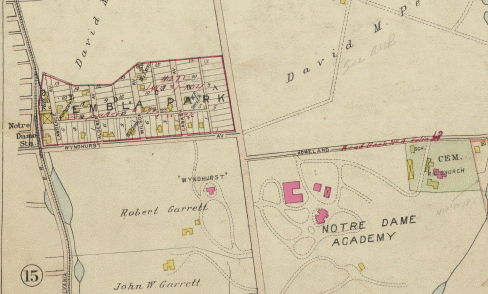
Source: 1915 Baltimore County Atlas by Bromley
Anton Jr. is listed in Baltimore directories as a florist from 1911 to 1918 at Wyndhurst and Lawrence Avenues. His frorist shop was east of Roland Park and west of Charles Street in an area called Embla Park.
| DATE | NAME | OCCUPATION | RESIDENCE | |
|---|---|---|---|---|
| 1887 | - | - | - | |
| 1888 | Spath, Anton | agt | 528 n. Castle | |
| 1889 | Spath, Anton | ins. | 528 n. Castle | |
| 1890 | Spath, Anton | grocer | 175 n. Chester | |
| 1891 | Spath, Anton | grocer | 1751 n. Chester | |
| 1892 | - | - | - | |
| 1893 | - | - | - | |
| 1894 | - | - | - | |
| 1895 | Spath, Anton Jr | ins. | Melvale NCRR | |
| 1896 | Spath, Anton Jr | ins. | Melvale NCRR | |
| 1897 | Spath, Anton Jr | farmer | Melvale | |
| 1898 | Spath, Anton Jr | lab | Cross Keys | |
| 1899 | - | - | - | |
| 1900 | - | - | - | |
| 1901 | - | - | - | |
| 1902 | - | - | - | |
| 1903 | Spath, Anton Jr | lab | Cross Keys | |
| 1904 | - | - | - | |
| 1905 | Spath, Anton | grocer | Falls Road near Cold Spring La | |
| 1906 | Spath, Anton Jr | grocer | Falls Road nr Cold Spring lane | |
| 1907 | Spath, Anton Jr | grocer | Falls rd nr Cold Spring la | |
| 1908 | Spath, Anton Jr | grocer | Falls rd nr Cold Spring la h do | |
| 1909 | Spath, Anton Jr | grocer | 190 Falls rd | |
| 1910 | Spath, Anton Jr | grocer | 190 Falls rd | |
| 1911 | Spath, Anton Jr | florist | Wyndhurst & Lawrence avs | |
| 1912 | Spath, Anton Jr | florist | Wyndhurst & Lawrence avs | |
| 1913 | Spath, Anton Jr | florist | Wyndhurst & Lawrence avs | |
| 1914 | Spath, Anton | florist | Wyndhurst & Lawrence avs | |
| 1915 | Spath, Antone | florist | Wyndhurst & Lawrence avs | |
| 1916 | Spath, Anton | florist | Wyndhurst & Lawrence avs | |
| 1917 | Spath, Anton | florist | Wyndhurst & Lawrence avs | |
| 1918 | Spath, Anton | florist | Wyndhurst & Lawrence avs | |
| 1920 | - | - | - | |
| 1921 | - | - | - |
Anna Marie Spath Anthon married George F. Anthon in about 1893 and lived at 1025 Falls Road. Their children were Antoinette, John William and George Dewey Anthon. Dewey died in 1911 at age 13. Some time before 1926, John William Anthon married Lula Yeagle, sister of George E. Yeagle and Lawrence Yeagle. The families were already connected because Edward Spath's sister, Madeline, married George E. Yeagle in about 1915. Anna Marie died on May 24,1913 when she was 46 and is buried in Baltimore Cemetery close to her father's grave.
Christina Spath Johnson and her husband Olaf Johnson (from Denmark) lived at 809 35th Street until they moved to 2943 Cedar Avenue in 1913. Both houses were in Baltimore City. Viola was their daughter. In the 1920 census, Viola and her husband (Thomas Carroll Pierce) lived at 1027 Falls Road. Her cousin John William Anthon and his wife Lula were their next door neighbors. The cousins were two of Anton Spath's grandchildren. Christina and Olaf also had three children who died at birth. Christina and Olaf are buried in the Mt. Lebanon section of the Parkwood Cemetery on Taylor Avenue between Harford and Belair Roads.

For twelve years before his death, Edward Spath operated a grocery store with George E. Yeagle. Edward's daughter Madeline was married to his partner, George. Their store was located on the east side of Falls Road south of Cold Spring Lane, at the north (left) end of the block, next to the alley. George and Madeline Yeagle lived at the south end of the same block. The building and the houses in that block were built in 1913 and are still standing today.
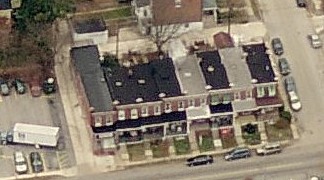
4400 block Falls Road
Source: Microsoft Live Search
Edward and Laura lived at 903 Cold Spring Lane from about 1912 to 1925. Edward died at 3PM on January 2, 1925 while he was shoveling snow. At 9PM that same day, his sister Christina died at her daughter's house in Washington, DC. Some time after 1930, Laura married Mr. Williams. Laura died in 1939. The 903 Cold Spring Lane house was sold after Mr. Williams death in the late 1940's. Edward and Laura are buried at a Spath/Yeagle family plot in the Woodale section of the Druid Ridge Cemetery.
| DATE | NAME | OCCUPATION | RESIDENCE |
|---|---|---|---|
| 1890 | - | - | - |
| 1891 | Spath, Edwd M | clk | 1202 Peabody |
| 1892 | - | - | - |
| 1893 | - | - | - |
| 1894 | Spath, Edwd | brakeman | 452 Turner pl |
| 1895 | Spath, Edwd M | brakeman | 425 w 24th n |
| 1896 | Spath, Edw M | brakeman | 425 w 24th n |
| 1897 | Spath, Edwd M | brakeman | 707 3rd av n |
| 1898 | Spath, Edwd M | brakeman | 707 3rd av n |
| 1899 | Spath, Edwd M | brakeman | 707 3rd av n |
| 1900 | Spath, Edwd M | brakeman | 707 3rd av n |
| 1901 | Spath, Edwd M | condtr | 707 3rd av n |
| 1902 | Spath, Edwd M | brakeman | 707 3rd av n |
| 1903 | Spath, Edwd M | brakeman | 707 3rd av n |
| 1904 | Spath, Edw M | lab | 707 3rd av n |
| 1905 | Spath, Edw M | brakeman | 707 3rd av n |
| 1906 | Spath, Edwd M | brakeman | 707 3rd av n |
| 1907 | Spath, Edwd M | condtr | 707 3rd av n |
| 1908 | Spath, Edwd M | brakeman | 707 3rd av n |
| 1909 | Spath, Edwd M | condtr | 707 3rd av n |
| 1910 | Spath, Edwd | carp | 707 3rd av n |
| 1911 | Spath, Edwd | carp | 707 3rd av n |
| 1912 | Spath, Edwd | carp | 903 Cold Spring Lane |
| 1913 | Spath, Edwd M | carp | 903 Cold Spring Lane |
| 1914 | Spath, Edwd M | carp | 903 Cold Spring av |
| 1915 | Spath, Edwd M | grocer | 903 Cold Spring la |
| 1916 | Spath, Edwd M | grocer | 903 Cold Spring la |
| 1917 | Spath, Edwd M | grocer | 903 Cold Spring la |
| 1918 | Spath, Edward M | grocer | 903 Cold Spring la |
| 1920 | Spath, Edward M | grocer | 903 Cold Spring la |
| 1921 | Spath, Edward M | grocer | 903 Cold Spring la |
| 1923 | Spath, Edw M | grocer | 903 Cold Spring la |
| 1924 | Spath, Edw M | grocer | 903 Cold Spring la |
| 1926 | - | - | - |
Anton and Anna Maria Spath had nine adult grandchildren, George Dewey Anthon (died at 13) and several that died as infants. Some had long lives and others died young. In addition to the grandchildren listed in table 5, Christina and Olaf Johnson had thee baby boys that died at birth and are buried at Western Cemetery in Baltimore.
| NAME | BIRTH | DEATH | AGE | PARENTS |
|---|---|---|---|---|
| S.M. Spath | about 1889 | July 20, 1889 | -- | Mary and Anton Spath Jr |
| Herbert W. Spath Sr | June 13, 1890 | May 20, 1976 | 85 | Mary and Anton Spath Jr |
| Lena Spath Mark | August 31, 1891 | December 9, 1969 | 78 | Mary and Anton Spath Jr |
| Ella Margaret Spath Ketler | November 21, 1892 | November 10, 1938 | 45 | Mary and Anton Spath Jr |
| Marie Antoinette Anthon Helms | October 15, 1893 | June 21, 1941 | 47 | Anna Marie and George Anthon |
| John William Anthon | February, 6, 1895 | August 18, 1954 | 59 | Anna Marie and George Anthon |
| Marie A. Spath | about 1895 | August 1895 | -- | Mary and Anton Spath Jr |
| Madeline Spath Yeagle | June 4, 1896 | December 31, 1969 | 73 | Laura and Edward Spath I |
| Viola Johnson Pearce Gray | January 27, 1897 | November 1987 | 90 | Christina and Olaf Johnson |
| Charlotte Augusta Spath | February 24, 1898 | September 24, 1898 | 6 mo | Mary and Anton Spath Jr |
| George Dewey Anthon | July 15, 1898 | August 12, 1911 | 13 | Anna Marie and George Anthon |
| Florence Anna Spath Mason | September 5, 1900 | March 1, 1989 | 88 | Mary and Anton Spath Jr |
| Edward M. Spath II | July 19, 1903 | July 22, 1964 | 61 | Laura and Edward Spath I |
The Jones Falls quarries that were located just north of the city line were considered to contain excellent examples of gneiss and granitic gneiss that was found in Baltimore County. (28) One of these quarries was operated on Anton's property. It was located high up on the hill behind his dwelling. Much of the stone for the roads of Roland Park was supplied from the quarry. (29) Roland Park was a planned community for the rich that was located a few blocks east of Anton's property. The community was incorporated in 1892 and grew from 250 homes in 1904 to 500 homes in 1910.(30) The planners tried to preserve the natural beauty of the landscape.
Anton used his willow grove along the Jones Falls to provide material for the baskets that he made and sold in the neighborhood or possibly at the market. The Jones Falls starts at the head of the Green Spring Valley; flows through alluvial material near Mt. Washington; rushes over broken rocks, across an alluvial meadow and over the crushed remains of rock ledges; and finally through the city. David Jones was the first settler along the Jones Falls and the stream was named after him. (31) A rainfall of 7 inches on July 24, 1868 produced a flood that inundated several thousand homes along the Jones Falls. (32) One hundred lives were lost and all the bridges except for the one at Eager Street were washed out. (33) The draught of 1872 caused different but serious problems along the Jones Falls valley. Topographic maps show that Anton's land was low and might have been affected by floods. The 1899 USGS Quadrangle shows several streams entering the Jones Falls in the Cross Keys area. It shows Cold Spring Lane running east-west, parallel and north of the city/county boundary. An area named Clyburn can be seen on the map west of the railroad tracks, north of Melvale and not too far from Anton's property. Horatio Nelson Gambrill owned a large estate in Clyburn, estimated to be worth $200,000 in the 1860 U.S. Census. He built the Druid Mill in 1866. When it was expanded in 1872, it was one of the largest cotton duck mills in the world. It was near the Jones Falls in Woodberry. (33a)
Bertha Spath told that Anton belonged to the First German Church. Records show that the German Baptist Church was organized in 1859 and moved to a new building at Caroline and Hampstead Streets in April 1867. (34) The church records may be in the possession of West Baltimore Baptist Church (formally Second Church). Anton's obituary tells that his funeral was held at the First German Baptist Church that was located at the corner of Monument and Patterson Park Avenues. Records of the church still have to be searched. Anton also attended Hampden Baptist Church and served as a deacon of the church for many years. The fiftieth anniversary book for the church tells that Anton was a delegate to the Maryland Baptist Union Association in October of 1888, 1889, 1890, 1896, 1898. His wife and children were delegates in many other years. (35) The Spath family always had doughnuts on Fat Tuesday. Shrove Tuesday or Fat Tuesday is the day before the beginning of Lent. Ash Wednesday is the first day of Lent and is 46 days before Easter (40 weekdays and 6 Sundays). This day was set aside as a special day of repentance. In the year 325, the church decided that Easter would fall on the first Sunday after the full moon that occurs on or after March 21. "Shrove" refers to the shriving or cleansing of sins by going to confession on this day. On the other hand, it was a day of feasting and carnival. The Germans called it "Fasching" or "Facsh Nacht". It was the time to use up their store of fat which was forbidden during Lent. Thus, many Germans used up the fat by making doughnuts on Shrove Tuesday.
The 1880 census lists Perry Knight and family as residents of the village of Cross Keys. It said that he was in the restaurant business. His wife's name was Lena (age 28) and there were five children, Mary (age 16), Annie (age 13), William (age 12), Perry (age 4) and Lena (age 2). The census shows that there were three boarders with the Knights. In addition, Nathan Mather and his family were in the same house.(35a)
On the east side of Falls Road (opposite the Cross Keys Inn), was a picnic grounds called the White Oak Grove. It had a dancing pavilion with polished floors under the trees.
Much of Anton's property was located on the east side of Falls Road (from Spath Lane on the south to Oakdale Road on the north). Anton owned a rental house at the corner of Falls Road and Oakdale Road and also four houses on the south side of Oakdale Road. The Colored M.E. Church was located on the north side of Oakdale Road. It was one of two churches in the village of Cross Keys during the early 1900's. The 1918 Maryland Legislative session describes the church property as bounded on the south by a lot owned by Anton Spath. The other church was on Falls Road, several houses south of Anton's property. On the 1915 map, its building was shown as a HALL.
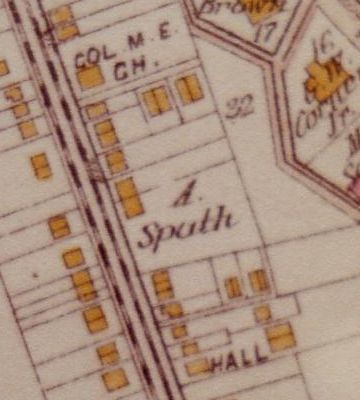
Anton's Two Church Neighbors
source: 1915 Baltimore County Atlas
Christoph Spath sent a letter to many Spaths in 1993 asking for information about the Spaths of Baltimore. Christoph lived in Vermont. I responded by providing a copy of the Anton story. Christoph's father, Bertold Karl Spath lived in Aschaffenburg, Germany and planed to visit America in September 1993. Aschaffenburg is located about 25 miles southeast of Frankfurt and 220 miles northwest of Munich. Aschaffenburg was a Roman settlement on the right bank of the Main River and has grown industrially in recent years.
Daniel Spath was Christoph Spath's great-grandfather. Christoph said that Daniel Spath was born on January 19, 1863 in Dietzenbach (Hessen) Germany and died on November 8, 1927 in Baltimore. Daniel's profession in Germany was a steel or leather "presser". Daniel's youngest son Franz was approximately 14 years old when he immigrated to Baltimore with his father. Franz and his oldest son (Frank) are the "Frank Spath" part of our family.
In Christoph's second letter, I received several family pictures and Bertold's family tree given to Christoph by his father, Bertold Spath.(35b) Christoph's father (as a youngster) and grandfather Karl Spath are shown in the picture below. Several generations of Bertold's family tree match the names and dates that I found at the family History Library in Salt Lake City. The Salt Lake City records show Heinrich Spath and Anna Maria Junger as Anton's parents while Bertold's family tree also includes them as Bertold's great-great-grandparents. Bertold's great grandfather, Johannes, was Anton's oldest brother.
Pat and Dan Spath also received a copy of Christoph's letter in 1993 and traveled from Baltimore to New Jersey to meet Bertold, Lottie and Christoph Spath. They were excited to visit the Ellis Island and checked out the Immigrants Wall of Honor. Dan retired in about 1980 and operates Time and Treasures, a clock repair shop in Ellicott City, MD.
Listed below is part of the family of Anton's brother Johannes Spath.
Johannes Spath (born September 28, 1821) married Anna Katherena Korb Spath on October 29, 1854
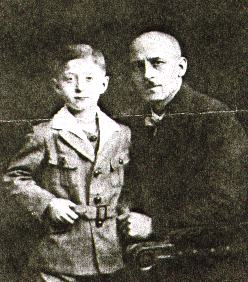
Passenger Ship Records show that four Spaths were aboard the S.S. Wein that sailed from Bremen, Germany on August 25, 1910. It arrived at the port of Baltimore on September 7, 1910. Anton and Auguste Späth were returning home to Rollen Park, Maryland. (Spelling was not always accurate in the ship logs). Daniel Späth and his 8year old son were also aboard the S.S. Wein. They were going to visit Uncle Anton Späth at 223 Falls Road, Roland Park, Maryland. Daniel was 5 foot 7 inches tall, had black hair, blue eyes and was born in Offenbach, Germany. Offenbach is a town in the state of Hesse, Germany and is only a few miles south east of Frankfurt. In addition to the four Spaths, the S.S. Wein passenger records also includes Frieda Pronys who was on her way to see Uncle Anton Spath at 223 Falls Road.
The 1911 Baltimore City Directory lists Danl Spath and Anton Spath both at 223 Falls Road. Daniel is listed in the 1923 City directory at 2571 Fdk av. From 1924 to 1927, Danl, Frank W, and Cath, are all listed in the Baltimore City Directories at 2517 w Lombard Street. The directories after 1927 only list Frank and Cath. An obituary in the Baltimore Morning Sun said that Daniel Spath, father of Frank W. Spath, died on November 6, 1927. He was buried in Mt. Olivet Cemetery.
The 1900 Census Records show that Anton's sister Annie M. was living with Anton at the time of the 1900 census. She was born in 1827, had six children, two living in 1900, and immigrated in 1856. It looks like the census taker might have combined some of Anton's information with his sister. She probably did not immigrate in 1856 with her brother Anton.
When I visited Salt Lake City, Utah in May 1991, I toured the Family History Library operated by the Church of Jesus Christ of the Latter Day Saints (LDS). The Family History Library was founded in 1894 to gather records that help people trace their ancestry. More than 1500 family history centers operate in 55 countries. The library in Salt Lake City and the other family history centers are open to the public. Family history centers are generally located in church meeting houses and are staffed by volunteers. Much information is now available on the LDS web site. The collection of records is important to the church and is not limited to the church, its members, or ancestors. It is a valuable source of information.
I found Anton Spath's name listed in the LDS Ancestral File. The Ancestral search file links individuals to families or pedigrees and is available on compact disk. In a matter of minutes (in 1991), I discovered four new generations of Spaths; Anton's parents, grandparents, great grandparents, and great great grandparents. The names and birth dates for those four generations were collected by Mae E. Sturgis of Las Vegas, Nevada. LDS records indicate that the source of information was the Evangelical Lutheran Church in Darmstadt, Germany. On one LDS "entry form", Mae Sturgis wrote that Mary Anna Bauer was her grandmother and was raised by Daniel Spath (1838-1900) and took his name. Mary Anna's mother was a widow when she came to this country and loved her stepfather. Mae Sturgis wrote that she prayed about this and felt that it was right to have her sealed to him.
LDS Family History records show that Anton's great grandfather Isaac Spath was born in Dettingen, AM in 1724. I found 10 Dettingens on a Global Gazetteer, a directory of the world's cities and towns. Several of the cities had unique names, such as: Dettingen am Albuch, Dettingen am Main, Dettingen an der Erms, Dettingen an der Iller and Dettingen unter Teck. Since nine of the ten locations were close to Stuttgart, my initial focus was on the towns that were located south of Stuttgart. Soon I realized that this was the wrong area, because the AM in the record stands for au main or on the Main River. Only one town (named Dettingen) was on the Main and it was located east of Frankfurt.
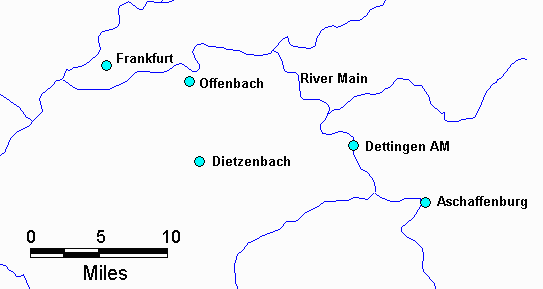
History tells that there was a Battle of Dettingen in July 1743. It was fought on the north bank of the Main River east of Frankfurt and 3 miles west of Aschaffenburg. King George II of Great Britain, with his sword raised high, led 50,000 allied troops against 70,000 French troops at the Battle of Dettingen. This was the last time that a reigning monarch personally led his troops in battle. The allied force called the Pragmatic Army, was comprised of British, Austrian and Hanoverian troops.
Isaac Spath was born in Dettingen in 1724. He was 19 years old and probably still living in the town when the Battle of Dettingen was fought in 1743. He married Judith Junger and from 1756 to September 1768 had six children while they lived in Dettingen. Their last child, Anton's grandfather Heinrich, was born in Dietzenbach in February 1771.
Anton's great-great grandparents: Konrad Spath and Karolie Zuck (married 1723)
| Child's Name | Birth | Birth Place | Death |
|---|---|---|---|
| Isaac Spath | May 23, 1724 | Dettingen, AM | May 17, 1805 |
Anton's great grandparents: Isaac Spath and Judith Jünger
| Child's Name | Birth | Birth Place | Death |
|---|---|---|---|
| Daniel Spath | March 29, 1756 | Dettingen, AM | |
| Marie Elizabeth Spath | January 7, 1758 | Dettingen, AM | 1804 |
| Conrad Spath | April 20, 1760 | Dettingen, AM | June 12, 1763 |
| Catharina Spath | July 30, 1763 | Dettingen, AM | 1834 |
| Martin Spath | March 1, 1766 | Dettingen, AM | December 27, 1770 |
| Margareta Spath | September 28, 1768 | Dettingen, AM | June 2, 1793 |
| Heinrich Spath I | February 11, 1771 | Dietzenbach | June 20, 1844 |
Anton's grandparents: Heinrich Spath I and M. Elizabeth Reitz (married July 1794)
| Child's Name | Birth | Birth Place | Death |
|---|---|---|---|
| Daniel Spath | April 7, 1795 | Dietzenbach | Jun 2, 1795 |
| Heinrich Spath II | April 4, 1796 | Dietzenbach | March 20, 1855 |
| Margarete Spath | May 5, 1798 | Dietzenbach | October 18, 1802 |
| Johannes Spath | January 14, 1800 | Dietzenbach | March 17, 1835 |
| baby Spath | October 8, 1802 | Dietzenbach | October 8, 1802 |
| Rudolf Spath | February 26, 1805 | Dietzenbach | 1870 |
Anton's parents: Heinrich Spath II and Anna Maria Jünger (married October 3, 1820)
| Child's Name | Birth | Birth Place | Death |
|---|---|---|---|
| Johannes Spath | September 28, 1821 | Dietzenbach | February 12, 1874 |
| Rudolph Spath | October 4, 1823 | Dietzenbach | October 26, 1886 |
| George Spath | October 21, 1825 | Dietzenbach | February 11, 1869 |
| Maria Spath | October 13, 1828 | Dietzenbach | |
| Margarete Spath | September 1, 1830 | Dietzenbach | |
| Anton Spath | March 3, 1835 | Dietzenbach | |
| Johann Daniel Spath | July 10, 1838 | Dietzenbach | January 24, 1900 |
Throughout the years, Anton's property holdings along Falls Road grew. The Baltimore County Court House records show that Anton purchased a lot on the west side of Falls road in April 1884. Four additional lots were obtained from a trustee sale in December 1884. An auction in March 1890 added more. A street intersecting Falls Road near Anton's house was called Spath's Lane. This unpaved lane might have provided access to the rock quarry. Anton owned at least 16 houses and lots by the end of his tenure. It has been told that most of these structures were without indoor plumbing and that the dwellings were inhabited by poor blacks. The 1906 picture shown below was taken from a point on Falls Road north of Anton's properties. (37) Falls Turnpike Road and the No.25 trolley line can be seen in the picture. Roland Park houses along Hillside Road and the tennis courts of the Baltimore Country Club can be seen in the background. A golf course and club house were also included in the development of the Baltimore Country Club. Part of the golf course was on the east side of Falls Road. When you looked the at the course from Falls Road, the layout wandered up the hill to a grand club house that was located at the top of the hill. (37b) After playing the starting hole, or maybe two, golfers crossed the road to play additional holes that were on the flatter west side of Falls Road. They had to hit over Falls Road on the 17th hole. Their final hole took them back up the hill to the club house. The purple figures on current topographic maps show that the recent additions, such as the Cross Keys complex was constructed on property obtained from the Baltimore Country Club west of Falls Road. Table 2 has a list of entries for Anton Spath in the Baltimore City Directories.

Anna Maria died on January 21, 1890 and is buried in Baltimore Cemetery. She was 51 years old. Their youngest child (Edward) celebrated his 17th birthday two days after his mother's death. Herbert Spath said that his grandmother died when he was 8 or 9 years old. I estimate that he would have been that old in about 1898. Since he was born about the time of Anna Maria's death, he could not possibly have remembered her death at all. I looked at old Sunpapers, recorded on Pratt Library microfilms, but could not find an obituary for Anna Maria.
The country faced a depression in 1893 that brought on numerous suicides, mostly by Germans. Financial panic spread, farm prices collapsed and there were many foreclosures. (38) The effect of depression on Anton's family is not clear. Court records would tell if this was the time when Anton acquired some of his property holdings. It has been suggested that Anton may have taken another wife after Anna Maria's death and before he married Augusta. Could this be the one that Herbert Spath remembered? The 1900 Census lists Anton's wife as Leana. The spelling was hard to read in the document and could have been Leana or Leanor, etc. Much of the census data about this wife is identical to that of his first wife Anna Maria.
A 1900 death certificate says that Magdalina Spath died at Cross Keys on Novermer 3, 1900 and was the wife of Anton Spath. She was Anton's second wife. Her name was spelled several different ways in documents (Magdaline, Magnalena, Leana, Lena, etc.) Lena was born in Prussia. In the 1880 census, Lena was the wife of Frederick Rumohr and five children were listed (Cristini, Julia, Henry, John and Luis). Frederick died on June 21, 1887 and is buried at Loudon Park Cemetery. Two of their children died in June 1899. The Baltimore Sun had obituaries.
Lewis died on two weeks later of typhoid fever.
The house at 300 South Monroe Street belonged to Frederick Rumohr before his death in 1887. The Rumohr family resided in the house. It is likely that daughter Julia Rumohr Hill and her husband Clarence Hill lived in the house after Lena's marriage to Anton Spath. In addition to the Hills, the 1910 census, shows that sister Christina Rumohr also lived at 300 South Monroe Street.
Anton's second wife died in November 1900 and is buried in Loudon Park Cemetery with her first husband, Frederick Rumohr and their sons.

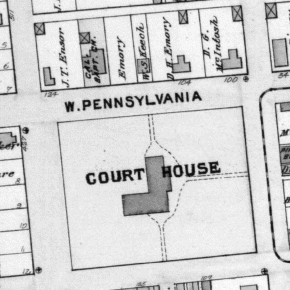
Towson, Maryland
Source: 1898 Baltimore County Atlas by Bromley
Augusta's husband before Anton was Otto Philip. She and Otto had at least three children, Frances Penske, Augusta Muth and Otto Philips. The spelling of the two daughter's names in Anton's will was slightly different from other spellings. The 1910 census lists Stephen Pensky, his wife and their five children as residing at 225 Falls Road, next door to Anton and Augusta. Stephen's wife, Francis was Augusta's daughter. In November 1913, Stephen Pensky lived at 1307 W. Lombard Street.
Bertha Loos Spath told many stories about her husband's grandfather. Anton Spath was a friend of the Loos family. When two of the church members were making fun of her parents, as they were cleaning the church, Anton snapped at them to keep their snoz where it belonged. All the children were afraid of the "old man". One day he caught her climbing the apple tree in his yard. She was so scared that she wet her pants. Augusta's granddaughter, Eleanor Penske Kretchmeier recited in German a poem called "Blackjack" for Anton's 70th birthday. She said that she was eight years old when she gave the recital. It was held at the German Baptist Church. In 1986, she was 93 years old and was living in the Baptist Home of Maryland.
On June 10, 1909 The Baltimore American newspaper carried a short article about Anton.
On December 20, 1912 Anton affixed his seal to his last will and testament. It is recorded at the Baltimore County Courthouse, liber W.J.P. 1908 1942, folio 51, book 17.(39) He directed that his estate be divided as follows:
Augusta Spath (for the term of her natural life only) $5,000
The will named Anton's friend Thomas Worthington Brundage Jr. as the executor of the estate. Where did the friend live? What was his occupation and what happened to the property?
Anton Spath Sr. died on March 14, 1913. He had just celebrated his 78th birthday earlier in the month. A notice in the Baltimore Sunday Morning Sun read as follows:

Anton was survived by his wife, his four children and some number of grandchildren, maybe ten. All lived relatively close.
Augusta died seven months after Anton's death. She was 70 years old and is buried with Anton in Baltimore Cemetery. Augusta's will was recorded at the Baltimore City Court House, folio 561, book 116.A notice in the Baltimore Sun read as follows:
The house at 223 Falls Road and the other property was to be divided evenly among Anton's children after Augusta's death, according to Anton's last will and testament. The property was offered for sale at public auction on June 25, 1914. A bid of $2500 was received and the offering was withdrawn. The property was again set for auction on August 4, 1914 and sold for $2810. Christina, Edward and Anton Jr each received 1/4 of the net proceeds. Anton's oldest daughter died two months after Anton, but before the property was sold. The remaining 25 percent was divided between the surviving husband of Mary Spath Anthon and their two children, John W. Anthon and Antoinette Anthon.
The current-day village of Cross Keys is a planned community developed by the Rouse Company with residential, retail and office components. It opened in September 1965. There are 30 shops and restraunts in the development. It is situated on 72 acres and includes 81000 square feet of retail and 189000 square feet of office space. The location of Anton's house is shown on this figure taken from the 1915 Baltimore County Atlas by George W. & Walter S. Bromley. A portion of Rouse's Cross Keys was built on land that had been Anton's willow grove.

Source: 1915 Baltimore County Atlas by George W. & Walter S.
Bromley
World War I put an end to the German-American era in Baltimore. Having a German name or a German sounding name was not popular. German Street was renamed Redwood Street, after the George Buchanan Redwood, the first officer to die in France during World War I. Many Germans changed the spelling or pronunciation of their names. The effect of these world occurrences on the Spaths of the 1910's is not totally clear. The Cross Keys area was incorporated into Baltimore City when the northern boundary of Baltimore City was moved to its current location in 1918 as the last chunk of Baltimore County was annexed.(40)

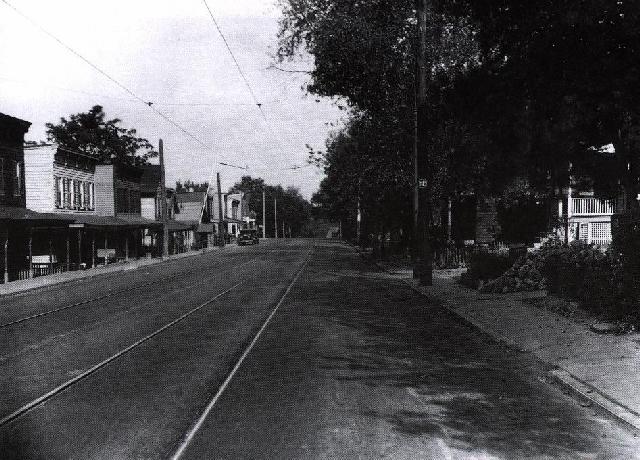

Back in the old days, John Gambrill owned the Cross Keys Tavern. Horatio Nelson Gambrill was John's son. The name of the tavern came from the crossed swords that hung over the door. It was managed by John's nephew, Perry Knight. When I was looking for Anton's name in the 1880 census, the only names that I recognized were Perry Knight and his family. Perry's Ordinary took its name from the early manager.(41)
Current topo maps show the location of the Poly-Western high school complex and the Cross Keys buildings that were constructed on the land that was previously home of the Baltimore Country Club. Cross Keys Quadrangle Building at 2 Hamill Road was constructed on the 11-acres that had previously been owned by Anton Spath.
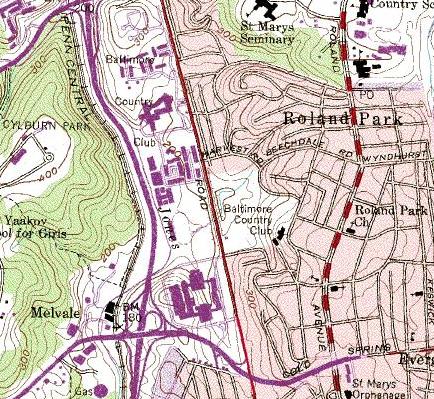
source: 1974 USGS Quadrangle
The village of Cross Keys is located north of the Poly-Western high school complex. When the Rouse Cross Keys development opened in 1965, it included a hotel called the Cross Keys Inn. An advertisement in the Baltimore Yellow Pages in the 1980's touted the Cross Keys Inn's distinctive accommodations. The Inn's address, 5100 Falls Road, reflected the street numbering system that went into operation after the city line was moved out to its present location. Radisson took over the hotel in the 1990's and advertises the hotel as the Radisson Hotel at Cross Keys. Its address is 100 Village Square. There are several conference rooms in the building, including the Knight and Mather rooms. The Knight room was named after Perry Knight. Crossroads is the new name for the restaurant in the hotel. The family tree shows the descendants of Anton Spath. Some names are missing from the chart. I will need some help to bring it up to date and to keep it current.
1. Baltimore Cemetery gravestones. East end of North Avenue near Gay Street, area J, walk 7, lot 5, north side.
2. Interview with Herbert Spath Sr. on December 27, 1975.
3. Mann, Golo. The History of Germany Since 1789. New York: Frederick A. Praeger Publishers, 1968, p.54.
3a. Baltimore, A Picture History 1858-1958, p.26.
4. Cunz, Dieter. The Maryland Germans. Port Washington, N.Y./London: Kennikat Press, 1972, p.201.
5. Scharf, Thomas. History of Baltimore City & County. Philadelphia, Pennsylvania: 1881, p.306.
6. Kelly, Jacques. Bygone Baltimore, A Historical Portrait. Norfolk, Virginia: Donning Company / Publishers, 1982, p.53.
7. Cunz, p.237.
8. Cunz, p.271.
8a. U.S. Census Records.
9. Letter from Ester Spath Robbins to Edward Spath Jr, dated July 8, 1986.
9a. Passenger and Immigration Lists (1820-1872) M255, Roll 11, List 56.
9b. Passenger and Immigration Lists (1820-1872) M255, Roll 11, List 48.
9c. Wilbur, C. Keith. Tall Ships of the World. Philadelphia, Chelsea House Publishers, 1997, p.10.
10. Baltimore City Marriages 1851-1865. Hall of Records, Annapolis, Maryland: CR10,277.
11. Baltimore Cemetery gravestone.
12. Baltimore County Real Estate records, Towson, MD., Book number 134 J.W.S.
13. Hopkins, G.M. 1877 Atlas.
13b. Letter from Viola Gray, dated Jan 3, 1979.
14. Baltimore County Real Estate records.
15. Papenfuse, Edward C. and Joseph M. Cade III. Atlas of Historical Maps of Maryland 1608-1908: The Hammond-Harwood House, 1982, figure 125, 1852 map by Chiffelle. p.107.
15a. Correspondence from Sean Mather.
16. Olson, Sherry. BALTIMORE The Building of an American City. Baltimore, MD: Johns Hopkins University Press, 1980, p.217.
17. Brooks, Neal and Eric Rockel. A History of Baltimore County. Towson, MD: Friends of the Towson Library Inc., 1979, p.277.
17b. Sheads, Scott Sumpter and Toomey, Daniel Carroll. Baltimore During the Civil War. Baltimore, Maryland: Toomey Press, 1997, p.78.
18. Olson, p.159.
19. Kelly, p.24.
19b. Melvale Distilling, source unknown.
20. Manakee,Harold. Maryland in the Civil War. Maryland Historical Society. March 1961, p. 38.
20b. Chapelle, Suzanne Ellery Green, Baltimore An Illustrated History, 2000, p.122.
20c. Sheads and Toomey, p.13.
20d. History of Roland Park.
21. Brooks & Rockel, pp.140-152.
22. Brooks & Rockel, p.143.
23. Brooks & Rockel, p.142.
24. Olson, pp.174-176.
25. Brooks & Rockel, p.265.
26. rose colored book from Archives.
26b. Baltimore County Circuit Court (Naturalization Certificates) 1879-1892, folio 765.
27. Baltimore Cemetery records.
27a. Roland Park Walking Tour, p15.
28. Scharf, p.22.
29. Weston, B. Latrobe. CrossKeys: Baltimore Evening Sun, February 13, 1934.
30. Olson, pp.217 & 213.
31. Scharf, p.15 & 208.
32. Olson, p.163.
33. Kelly, p.24.
33a. McGrain, John. Light Rail History and Scenery, 2005.
34. Scharf, p.566.
35. Fiftieth Anniversary of Hampden Baptist Church. pp.51 & 141.
36. Interview with Herbert Spath, Sr.
36a. Passenger Ship Records 1910.
36b. Miller, Mark B. Baltimore Transitions, Views of an American City in Flux. Baltimore and London: Johns Hopkins Press, 1998, p224.
37. Baltimore A Picture History 1858-1967. Baltimore, Maryland: Bodine & Associates, 1968, p.101.
37b. Ottenheimer postcard series, R34580 Baltimore Country Club, Roland Ave. pm 1913 PWB.
38. Olson, p.228.
38b. Baltimore County Real Estate records, Towson, MD., Book number 248 folio 494.
38c. Baltimore Sun, January 4, 1901.
39. Baltimore County courthouse, Towson, MD.
40. Brooks & Rockel, p.337.
41. Beyond the White Marbel Steps. Livlier Committee of the Citizens Planning & Housing Association: August 1979, p.35.